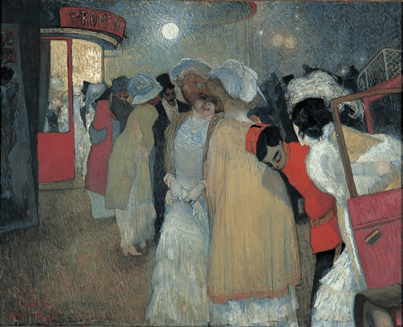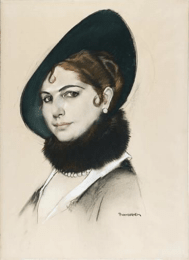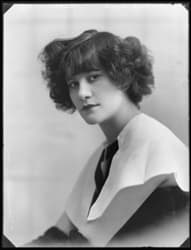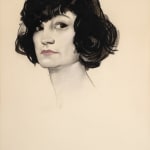Piet van der Hem (1885 - 1961)
Odette
Signed lower right: P.VANDERHEM.
Titled upper right: ODETTE
Pastel on paper
60.5 x 45 cm. (23 ¾ x 17 ¾ in.)
Provenance:
Odette
Signed lower right: P.VANDERHEM.
Titled upper right: ODETTE
Pastel on paper
60.5 x 45 cm. (23 ¾ x 17 ¾ in.)
Provenance:
Kunsthandel H. Bos, Den Haag, before 1935.
The undeniably alluring Odette, with her jet-black, wavy bob-cut and pastel pink lipstick, stares confidently out at the viewer. Though we cannot as yet be definitive of her identity, Odette was very likely drawn around 1915, in the years when Piet van der Hem was at his most original and forceful.
Piet van der Hem was born in 1885, the son of a merchant. Orphaned at the age of 12, he was taken in by his uncle and aunt. Encouraged by a secondary school teacher to become an artist, Hem went to Amsterdam in 1902 to study at the Rijksschool and Rijksakademie. His talents won him a Royal Grant in 1907, enabling him to study for a year in Paris, where, enraptured by Montmartre, and the art of Toulouse-Lautrec, he made a large number of paintings and drawings of Parisian nightlife (fig. 1).

Fig. 1, Piet van der Hem, Moulin Rouge, oil on canvas, 81 x 100 cm, Private Collection
With the advent of World War I and the political maelstrom that engulfed Europe, Hem transformed himself into an editorial cartoonist of biting social commentary, with his work regularly appearing in The New Amsterdammer. At the same time, he realised several striking bust-length pastel portraits of prominent female cultural figures from the time, including the actress Enny Vrede and the dancer Mata Hari (fig. 2, 1914), who was famously executed as a German spy in 1917. Odette clearly forms part of this highly-individual and memorable series of avant-garde femme-fatales, all of very similar dimensions, which must count amongst the most impactful and forward-thinking portraits executed in Holland at this time.

Fig. 2, Piet van der Hem, Mata Hari, 1914, pastel on
paper, 64 x 47 cm, Private Collection
Odette is possibly a portrait of the Frenchwoman Odette Myrtil (1898-1978), who began her career on the vaudeville stage in Paris at the age of 14, before expanding into acting and singing. Her first major success came in London in 1916, when she appeared in the West End show The Bing Boys Are Here. A photograph taken of her in that year shows striking similarities to van der Hem’s portrait (fig. 3). Indeed, between 1916 and 1923, when Myrtil moved to New York, she appeared regularly on the London stage and appeared in several other vaudeville productions in major European cities, so there would likely have been opportunity for her to visit Amsterdam.

Fig. 3, Bassano Ltd, Odette Myrtil, 1916, glass negative,
62 x 48 cm, National Portrait Gallery
As for van der Hem, he continued with his political cartoons until the 1930s, until the Nazi occupation of Holland stifled the Dutch free press. At this point, the artist turned to respectable society portraits, which he would continue with for the rest of his career. He also appeared three times at the Olympics (1924, 1932 and 1936), when painting was accepted as an Olympic discipline.



